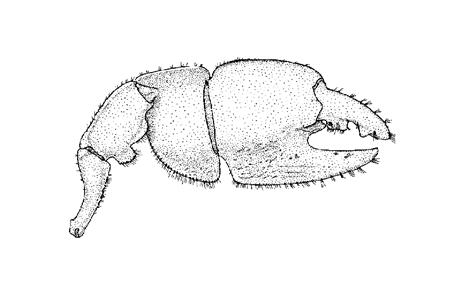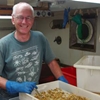General Description
Fourth segment (merus) of larger claw (cheliped) with serrated tooth and ridge on lower margin; fifth segment (carpus) in male shorter than broad; sixth segment (propodus) excavate and with minor tooth in gape; fixed finger straight; last segment(dactylus) irregularly dentate, more so in male. Tail fan (telson) longer than wide, as long as uropods. Body white, tinged with red, up to 8 cm long.
Biology
All ghost shrimps are burrowers, either making complex tubular branching burrows in muddy and sandy sediments or living in crevices under rocks and corals. This burrowing behaviour make them an important part of the marine environment. During feeding and burrow construction, they are continuously processing the sediment causing mixing and transportation of particles and gases. Each species creates a unique burrow plan which in turn has a different effect on the sediment and nutrient dynamics of the system. The presence of burrows ultimately increases the oxygen content of the sediment leading to a healthier system.
Habitat
Intertidal and shallow subtidal mudflats and sandy beaches, to 13 m depth.
Soft substrates
Distribution guide
Southern temperate oceans, including southern Australia.
Species Group
Prawns, shrimps, lobsters › Ghost and mud shrimps
Depth
Shore (0-1 m)
Shallow (1-30 m)
Water Column
Max Size
8 cm
Diet
Organic matter
Harmful
Not harmful but a nip from large claws could be painful
Commercial Species
No
Global Dispersal
Native to Australia
Species Code
MoV 1007
Conservation Status
- DSE Advisory List : Not listed
- EPBC Act 1999 : Not listed
- IUCN Red List : Not listed






